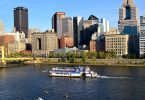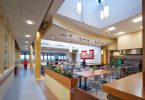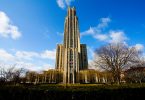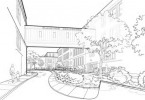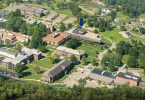Pittsburgh has a strong history of exploring new transportation options. From the 1960s Skybus to the modern-day proposed FAST TRAIN, Pittsburghers have embraced the idea of new forms of transportation. Even if the new forms of transportation do not always come to fruition in Pittsburgh, the technology builds a stronghold of innovation in the city.
2017– Hyperloop One From Pittsburgh-Columbus-Chicago
The Mid-Ohio Regional Planning Commission, in Columbus, is one of 35 global semifinalists for the Hyperloop One Challenge. Their proposal, the Midwest Connect, would connect Pittsburgh to Columbus to Chicago. It would take less than half an hour to get from one end of the route to the other!
Hyperloop One, based in Los Angeles, is developing a system to move freight and passengers at speeds up to 700 mph in pods that use low-pressure tubes and magnetic force. Since being named a Semi-finalist for the competition in January 2017, Mid-Ohio has begun working with officials in all three cities to create a more detailed proposal. While it is still in the planning stages, Pittsburgh officials are gearing up for the extended proposal.
Contact the Mid-Ohio Regional Planning Commission: phone: 614.228.2663
Watch a more detailed video on the Hyperloop One here:
2011– Bus Rapid Transit (BRT)
In 2011, a group of community stakeholders came together to propose a rapid transit system through the city’s busiest corridor–the neighborhood of Oakland (with the University of Pittsburgh, Carnegie Mellon University, and numerous hospitals) to Downtown Pittsburgh.
The goal of BRT was to reduce traffic through downtown by providing an efficient transit service:
- By moving buses out of the main travel lanes, easing traffic flow for other vehicles
- By reducing commuter cars. BRT provides frequent, reliable transportation that is so convenient, commuters choose BRT over riding in their own vehicles
Additionally, BRT was proposed to help improve the neighborhoods along the route by providing them with spurred business activity by the stops and to increase property values by being near reliable transportation.

A map of the proposed BRT route, courtesy of GetTherePgh
BRT was never adopted, but the idea remains the same. Pittsburghers are constantly brainstorming ways to improve their city and create more reliable transportation.
BRT was housed out of Sustainable Pittsburgh.
Contact:
Ginette Walker Vinski, Communications Director at Sustainable Pittsburgh
gvinski@sustainablepittsburgh.org; 412-258-6642
1960s-1970s– Pittsburgh Skybus
The Pittsburgh Skybus was an automated, rubber-tired vehicle running on a separate cement guideway– or, a new form of rapid transit developed by the Westinghouse Electric Company. The Skybus was proposed because Pittsburgh still lacked an effective public transportation system and the region had not diversified beyond a manufacturing base that specialized in primary metals. This new form of transportation not only would have solved the city’s transportation problem but would have served as a showcase to promote the city as a center of the rapid transportation industry.
Public support floundered by the late 1970s due to political opposition. A demonstrator car was built and operated in Pittsburgh’s South Hills, but the plan was abandoned in favor of the light-rail system, The “T,” that continues to this day.
The Skybus is still on display at the Bombardier Transportation facility in the South Hills and is viewed nostalgically by many Pittsburghers.
Watch below for a glimpse at the proposed Skybus.




